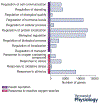The role of extracellular vesicles in skeletal muscle and systematic adaptation to exercise
- PMID: 31944292
- PMCID: PMC7363579
- DOI: 10.1113/JP278929
The role of extracellular vesicles in skeletal muscle and systematic adaptation to exercise
Abstract
Regular exercise has a central role in human health by reducing the risk of type 2 diabetes, obesity, stroke and cancer. How exercise is able to promote such systemic benefits has remained somewhat of a mystery but has been thought to be in part mediated by the release of myokines, skeletal muscle-specific cytokines, in response to exercise. Recent studies have revealed skeletal muscle can also release extracellular vesicles (EVs) into circulation following a bout of exercise. EVs are small membrane-bound vesicles capable of delivering biomolecules to recipient cells and subsequently altering their metabolism. The notion that EVs may have a role in both skeletal muscle and systemic adaptation to exercise has generated a great deal of excitement within a number of different fields including exercise physiology, neuroscience and metabolism. The purpose of this review is to provide an introduction to EV biology and what is currently known about skeletal muscle EVs and their potential role in the response of muscle and other tissues to exercise.
Keywords: exercise; extracellular vesicles; microRNAs; skeletal muscle.
© 2020 The Authors. The Journal of Physiology © 2020 The Physiological Society.
Conflict of interest statement
Competing interests
The authors declare no competing interests.
Figures




Similar articles
-
Emerging role of extracellular vesicles in the regulation of skeletal muscle adaptation.J Appl Physiol (1985). 2019 Aug 1;127(2):645-653. doi: 10.1152/japplphysiol.00914.2018. Epub 2019 Jun 13. J Appl Physiol (1985). 2019. PMID: 31194602 Free PMC article. Review.
-
Obesity and exercise training alter inflammatory pathway skeletal muscle small extracellular vesicle microRNAs.Exp Physiol. 2022 May;107(5):462-475. doi: 10.1113/EP090062. Epub 2022 Apr 3. Exp Physiol. 2022. PMID: 35293040 Free PMC article.
-
Functional Role of Extracellular Vesicles in Skeletal Muscle Physiology and Sarcopenia: The Importance of Physical Exercise and Nutrition.Nutrients. 2024 Sep 13;16(18):3097. doi: 10.3390/nu16183097. Nutrients. 2024. PMID: 39339697 Free PMC article. Review.
-
From sweat to hope: The role of exercise-induced extracellular vesicles in cancer prevention and treatment.J Extracell Vesicles. 2024 Aug;13(8):e12500. doi: 10.1002/jev2.12500. J Extracell Vesicles. 2024. PMID: 39183543 Free PMC article. Review.
-
Exosomes as Mediators of the Systemic Adaptations to Endurance Exercise.Cold Spring Harb Perspect Med. 2018 Mar 1;8(3):a029827. doi: 10.1101/cshperspect.a029827. Cold Spring Harb Perspect Med. 2018. PMID: 28490541 Free PMC article. Review.
Cited by
-
Fusion-Independent Satellite Cell Communication to Muscle Fibers During Load-Induced Hypertrophy.Function (Oxf). 2020;1(1):zqaa009. doi: 10.1093/function/zqaa009. Epub 2020 Jul 6. Function (Oxf). 2020. PMID: 32864621 Free PMC article.
-
Extracellular vesicle characteristics and microRNA content in cerebral palsy and typically developed individuals at rest and in response to aerobic exercise.Front Physiol. 2022 Dec 21;13:1072040. doi: 10.3389/fphys.2022.1072040. eCollection 2022. Front Physiol. 2022. PMID: 36620222 Free PMC article.
-
Exerkines in health, resilience and disease.Nat Rev Endocrinol. 2022 May;18(5):273-289. doi: 10.1038/s41574-022-00641-2. Epub 2022 Mar 18. Nat Rev Endocrinol. 2022. PMID: 35304603 Free PMC article. Review.
-
Efficacy of Lactococcus lactis subsp. lactis LY-66 and Lactobacillus plantarum PL-02 in Enhancing Explosive Strength and Endurance: A Randomized, Double-Blinded Clinical Trial.Nutrients. 2024 Jun 18;16(12):1921. doi: 10.3390/nu16121921. Nutrients. 2024. PMID: 38931275 Free PMC article. Clinical Trial.
-
Roles of Myokines and Muscle-Derived Extracellular Vesicles in Musculoskeletal Deterioration under Disuse Conditions.Metabolites. 2024 Jan 26;14(2):88. doi: 10.3390/metabo14020088. Metabolites. 2024. PMID: 38392980 Free PMC article. Review.
References
-
- Alvarez-Erviti L, Seow Y, Yin H, Betts C, Lakhal S & Wood MJ (2011). Delivery of siRNA to the mouse brain by systemic injection of targeted exosomes. Nat Biotechnol 29, 341–345 - PubMed
-
- Anderson HC, Garimella R & Tague SE (2005). The role of matrix vesicles in growth plate development and biomineralization. Front Biosci 10, 822–837. - PubMed
-
- Babst M, Katzmann DJ, Estepa-Sabal EJ, Meerloo T & Emr SD (2002a). Escrt-III: an endosome-associated heterooligomeric protein complex required for mvb sorting. Dev Cell 3, 271–282. - PubMed
-
- Babst M, Katzmann DJ, Snyder WB, Wendland B & Emr SD (2002b). Endosome-associated complex, ESCRT-II, recruits transport machinery for protein sorting at the multivesicular body. Dev Cell 3, 283–289. - PubMed
Publication types
MeSH terms
Grants and funding
LinkOut - more resources
Full Text Sources
Medical

